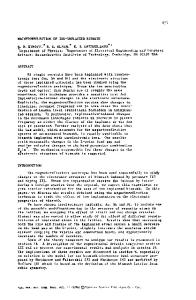High Current Gain Triple Ion Implanted 4H-SiC BJT
- PDF / 112,529 Bytes
- 4 Pages / 612 x 792 pts (letter) Page_size
- 44 Downloads / 275 Views
1195-B08-03
High Current Gain Triple Ion Implanted 4H-SiC BJT T. Tajima, T. Nakamura, Y. Watabe, M. Satoh, T. Nakamura Hosei University, Koganei, Tokyo 184-8584, Japan
ABSTRACT We investigated triple ion implanted 4H-SiC BJT with etched extrinsic base regions. To remove the defects induced by ion implantation between emitter and base regions, the characteristics of triple ion implanted 4H-SiC BJT were significantly improved. Maximum common current gain was improved from 1.7 to 8.4. INTRODUCTION SiC is a promising material for high temperature and frequency devices because of high breakdown field strength and wide bandgap. A lot of work has been done in recent on SiC devices. Especially, SiC bipolor junction transistors (BJTs) are expected to be high temperature devices. In the fabrication process of SiC BJT, the ion implantation was only used to form p+ contact region to the base because crystal defects remain in the ion implanted emitter and base regions [1]-[2] which increase base recombination current, decrease current gain and affect the quality and reliability. On the other hand, we reported excellent characteristics of 4H-SiC BJT devices with fabricating only ion implantation techniques [3]. An increase in the current gain can be expected by improving reliability by removing the crystal defect layer formed with the ion implantation which changes the main base current pass from the emitter side into the intrinsic region. In this study, we demonstrate the technology to improve the current gain of triple ion implanted 4H-SiC BJT device by etching the extrinsic base regions, namely crystalline defects induced by ion implantation. EXPERIMENT (0001)4H-SiC n-type epitaxial substrate was used for fabricating triple ion implanted 4H-SiC BJT. The annealing for activating acceptors of base and base contact regions were carried out using radio frequency inductive furnace at 1700 oC for 30 min in argon gas flow. And emitter was formed by multiple nitrogen and phosphorus ion implantation. The annealing for activating donors of emitter region was carried out by using radio frequency inductive furnace at 1700 oC for 10 min in argon gas flow. In order to passivate the surface of the sample, the thermal oxide layer with a thickness of 10 nm was formed by dry O2 sacrificial oxidation at 1150 oC for 1.5 hr, followed by the deposition of spin-on glass (SOG) with a thickness of 170 nm. The ohmic contacts to base and emitter were fabricated by depositing nickel metal layer with a thickness of 120 nm and subsequently annealing at 900 oC for 3 min in argon gas flow. Finally, aluminum electrode layer with a thickness of 200 nm was deposited onto the base and emitter nickel contact and the back surface for collector contact. Figure 1 schematically illustrates the structure of fabricated triple ion implanted 4H-SiC BJT.
The n- epilayer, namely the collector of this device, is 4.2 µm and has a dose of 1 x 1016/cm3. The width of intrinsic base and emitter were 300 and 500 nm, respectively. The base contact region to base with a depth o
Data Loading...










